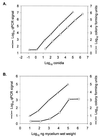Quantitative PCR assay to measure Aspergillus fumigatus burden in a murine model of disseminated aspergillosis: demonstration of efficacy of caspofungin acetate
- PMID: 11709327
- PMCID: PMC90856
- DOI: 10.1128/AAC.45.12.3474-3481.2001
Quantitative PCR assay to measure Aspergillus fumigatus burden in a murine model of disseminated aspergillosis: demonstration of efficacy of caspofungin acetate
Abstract
Caspofungin acetate (MK-0991) is an antifungal antibiotic that inhibits the synthesis of 1,3-beta-D-glucan, an essential component of the cell wall of several pathogenic fungi. Caspofungin acetate was recently approved for the treatment of invasive aspergillosis in patients who are refractory to or intolerant of other therapies. The activity of 1,3-beta-D-glucan synthesis inhibitors against Aspergillus fumigatus has been evaluated in animal models of pulmonary or disseminated disease by using prolongation of survival or reduction in tissue CFU as assay endpoints. Because these methods suffer from limited sensitivity or poor correlation with fungal growth, we have developed a quantitative PCR-based (qPCR) (TaqMan) assay to monitor disease progression and measure drug efficacy. A. fumigatus added to naïve, uninfected kidneys as either ungerminated conidia or small germlings yielded a linear qPCR response over at least 4 orders of magnitude. In a murine model of disseminated aspergillosis, a burden of A. fumigatus was detected in each of five different organs at 4 days postinfection by the qPCR assay, and the mean fungal load in these organs was 1.2 to 3.5 log(10) units greater than mean values determined by CFU measurement. When used to monitor disease progression in infected mice, the qPCR assay detected an increase of nearly 4 log(10) conidial equivalents/g of kidney between days 1 and 4 following infection, with a peak fungal burden that coincided with the onset of significant mortality. Traditional CFU methodology detected only a marginal increase in fungal load in the same tissues. In contrast, when mice were infected with Candida albicans, which does not form true mycelia in tissues, quantitation of kidney burden by both qPCR and CFU assays was strongly correlated as the infection progressed. Finally, treatment of mice with induced disseminated aspergillosis with either caspofungin or amphotericin B reduced the A. fumigatus burden in infected kidneys to the limit of detection for the qPCR assay. Because of its much larger dynamic range, the qPCR assay is superior to traditional CFU determination for monitoring the progression of disseminated aspergillosis and evaluating the activity of antifungal antibiotics against A. fumigatus.
Figures




References
-
- Abruzzo G K, Flattery A M, Gill C J, Kong L, Smith J G, Krupa D, Pikounis V B, Kropp H, Bartizal K. Evaluation of water-soluble pneumocandin analogs L-733560, L-705589, and L-731373 with mouse models of disseminated aspergillosis, candidiasis, and cryptococcosis. Antimicrob Agents Chemother. 1995;39:1077–1081. - PMC - PubMed
-
- Abruzzo G K, Flattery A M, Gill C J, Kong L, Smith J G, Pikounis V B, Balkovec J M, Bouffard A F, Dropinski J F, Rosen H, Kropp H, Bartizal K. Evaluation of the echinocandin antifungal MK-0991 (L-743,782): efficacies in mouse models of disseminated aspergillosis, candidiasis, and cryptococcosis. Antimicrob Agents Chemother. 1997;41:2333–2338. - PMC - PubMed
-
- Abruzzo G K, Gill C J, Flattery A M, Kong L, Leighton C, Smith J G, Pikounis V B, Bartizal K, Rosen H. Efficacy of the echinocandin caspofungin against disseminated aspergillosis and candidiasis in cyclophosphamide-induced immunosuppressed mice. Antimicrob Agents Chemother. 2000;44:2310–2318. - PMC - PubMed
MeSH terms
Substances
LinkOut - more resources
Full Text Sources
Other Literature Sources
Medical

